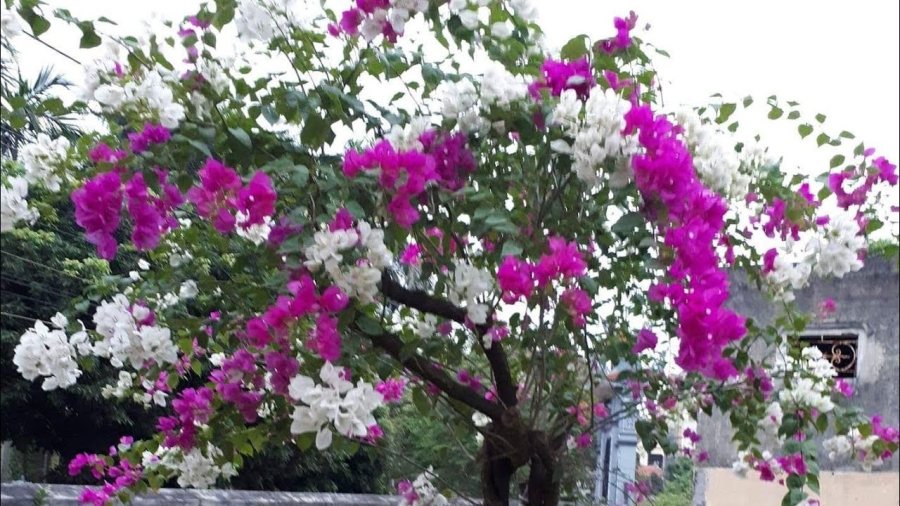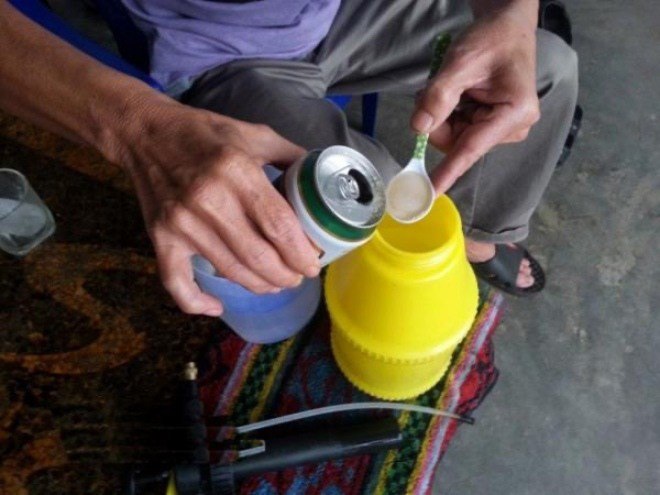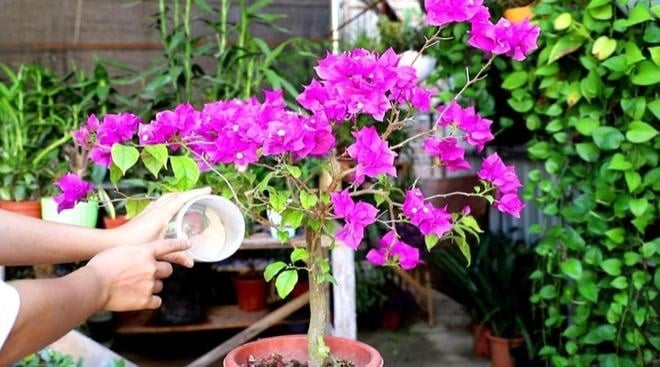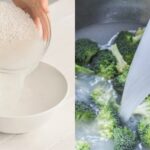The Bougainvillea, or hoa giấy, is a popular plant in Vietnamese households due to its resilience, low water needs, and vibrant, long-lasting flowers. In Feng Shui, the plant is believed to bring happiness, good fortune, and prosperity to its owners. It is also trusted to ward off evil spirits, making it a common fixture in homes.

Bougainvillea thrives in hot and dry conditions. While it will grow faster and produce lusher leaves in nutrient-rich soil, it will take longer to flower compared to when planted in drier, cooler conditions.
Interestingly, the better the care, the less likely the plant is to flower. Therefore, to enjoy a blooming Bougainvillea year-round, you’ll need to adopt specific care techniques.
Mixing Water and Beer

Mixing a cup of beer with water creates an ideal solution for nourishing your Bougainvillea and encouraging year-round blooms.
Experienced gardeners, especially those tending to flowering plants like Bougainvillea, often recommend using leftover beer to water their greenery. This method helps nourish the plant, encouraging more vibrant and long-lasting blooms. Here are some of the fantastic benefits beer offers your Bougainvillea:
Beer contains a significant amount of sugar, starch, and water—up to 90%. However, this concentration is still too high for the plant’s needs, so dilution is necessary before using it as a fertilizer. Once absorbed into the soil, the beer’s nutrients become readily available to the plant, acting as a natural fertilizer. Watering your Bougainvillea with beer will lead to a healthier, more vibrant plant over time.
The sugar and yeast in beer feed beneficial bacteria in the soil, creating an optimal environment for your Bougainvillea. In addition to using beer to water your Bougainvillea, you can also use it on other flowering potted plants like petunias and roses. However, it’s essential to pour the beer directly onto the soil rather than on the leaves, as this could harm the plant.
Leftover beer can also repel various pests that may damage your plants, protecting all parts of your greenery. Creatures like snails, wasps, fruit flies, and cockroaches detest the smell of beer. So, instead of discarding leftover beer, use it to keep your vegetable patches green and pest-free, ensuring the safety of your produce.
For this method, dilute the beer with water at a ratio of 1:30, mix well, and water your Bougainvillea. Avoid over-concentrated mixtures, as they can generate excessive heat and potentially rot the roots. Water your plant with this solution once every 20 days, and you’ll soon notice significant improvements.
How to Encourage Abundant Blooms
The following tips will help your Bougainvillea produce an abundance of flowers:
– After each flowering cycle, prune the plant to shape it and add well-rotted organic matter to the soil.

Caring for your Bougainvillea
– During the growth phase (when the plant produces new leaves), apply inorganic fertilizer or foliar spray.
– When the plant is growing and producing new shoots and leaves (approximately 2–3 months), it will have the strength for a new round of flowers. At this point, provide fertilizers high in potassium or phosphorus, divided into two applications, and ensure adequate watering for optimal nutrient absorption. Space these feedings 10–15 days apart.
– Initiate the treatment phase by gradually reducing the amount of water you give the plant until you stop watering it altogether. This transition to a waterless period is crucial for the plant’s reproductive phase (flower production). For Bougainvillea planted directly in the ground, you can withhold water for 3–5 days. For potted plants, monitor the soil daily, and if it becomes too dry, lightly water to maintain some moisture without overdoing it. Maintain this dry period for 5–7 days, then resume watering but be moderate.
– When you notice new leaves forming in small clusters with a slightly darker shade and small buds appearing on the stems, your Bougainvillea is entering the flowering stage.
– To ensure vibrant, long-lasting blooms, periodically spray the plant with vitamin B1 and flower-boosting fertilizer once a week. Maintain moderate watering, avoiding over-watering, as this can cause bud drop. Morning watering is best, especially during the flowering phase.
These tips will help you enjoy a vibrant, blooming Bougainvillea. Happy gardening!
“The Money Tree Makeover: Supercharge Your Plant’s Growth with This Magical Elixir”
“Don’t underestimate the power of money tree plants; just like any other flowering plant, they too need their fair share of attention and care. Think of extra phosphorous as their growth hormone, giving them the boost they need to flourish and thrive. So, don’t skimp on the fertilizer – give your money tree the nutrients it deserves to grow tall and strong.”
Does the Bougainvillea Plant in Front of the House Bring Good Family Feng Shui?
According to Feng Shui principles, certain plants and flowers are believed to bring good fortune and harmony to those who display them in their homes or gardens. One such plant is the beautiful and vibrant bougainvillea. So, which ages is this plant most compatible with, and why? Let’s explore the fascinating connection between bougainvillea and personal numerology through the lens of Feng Shui.



































